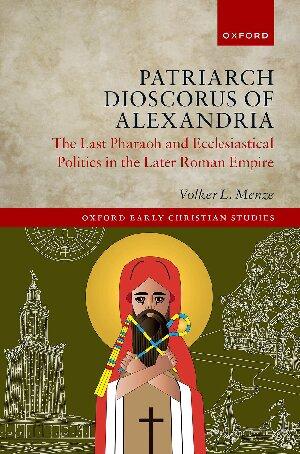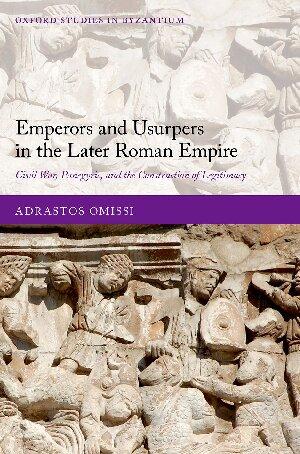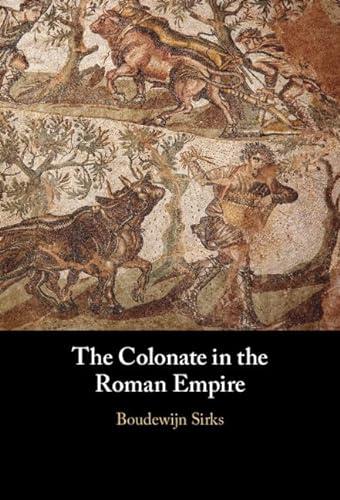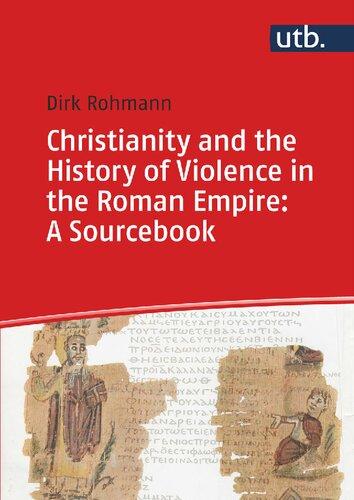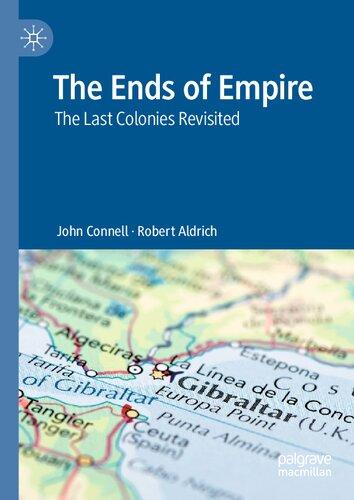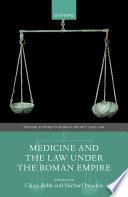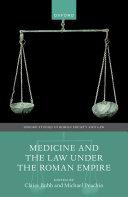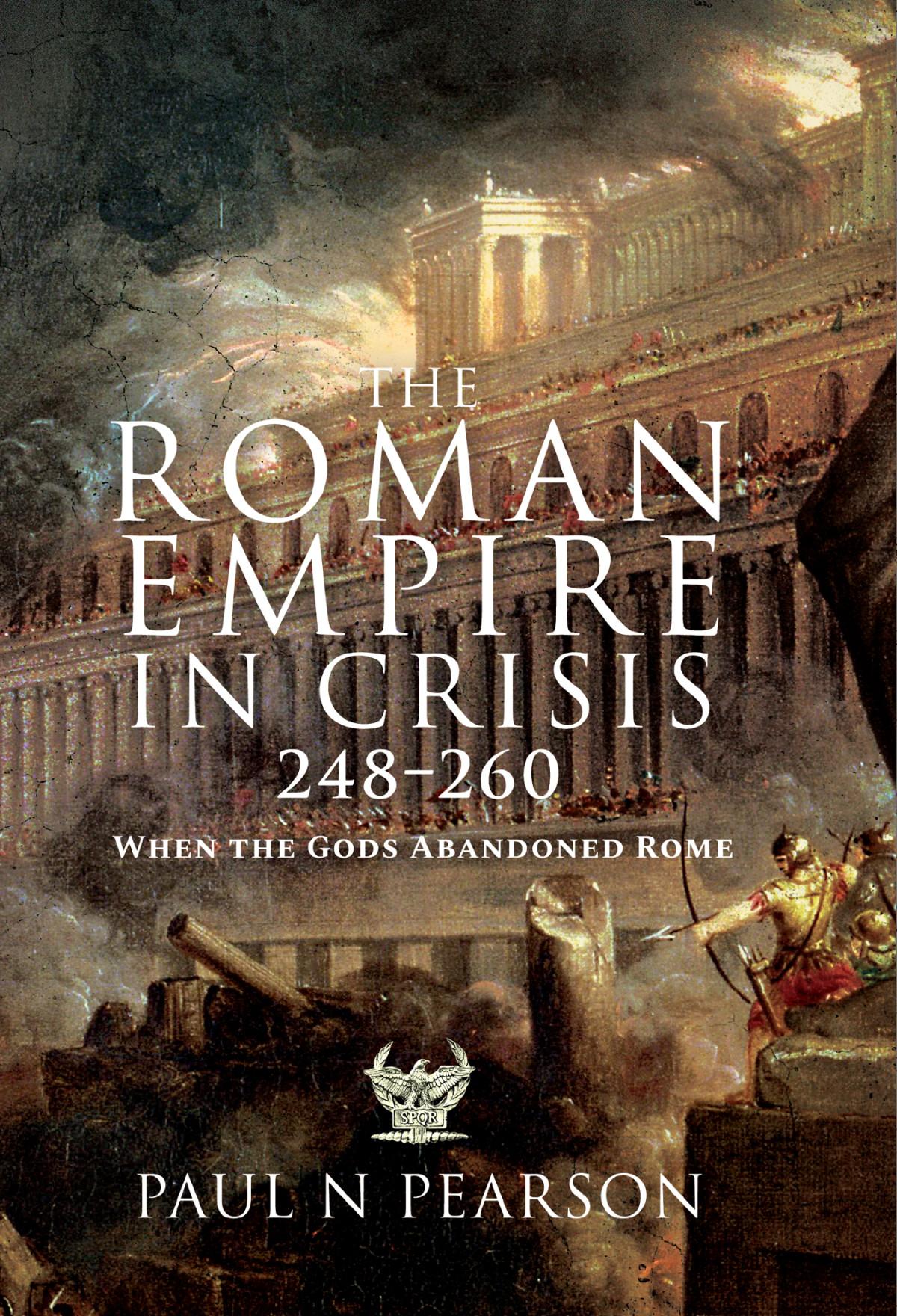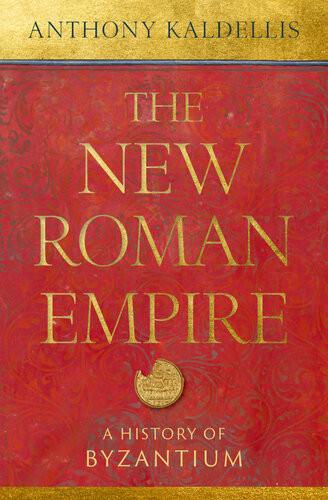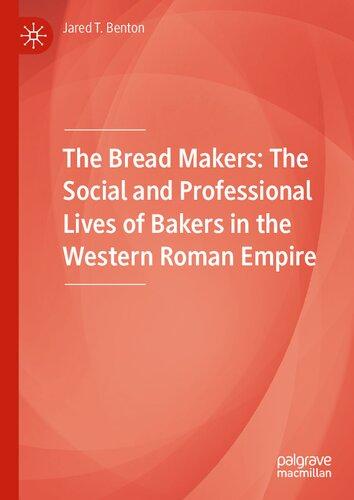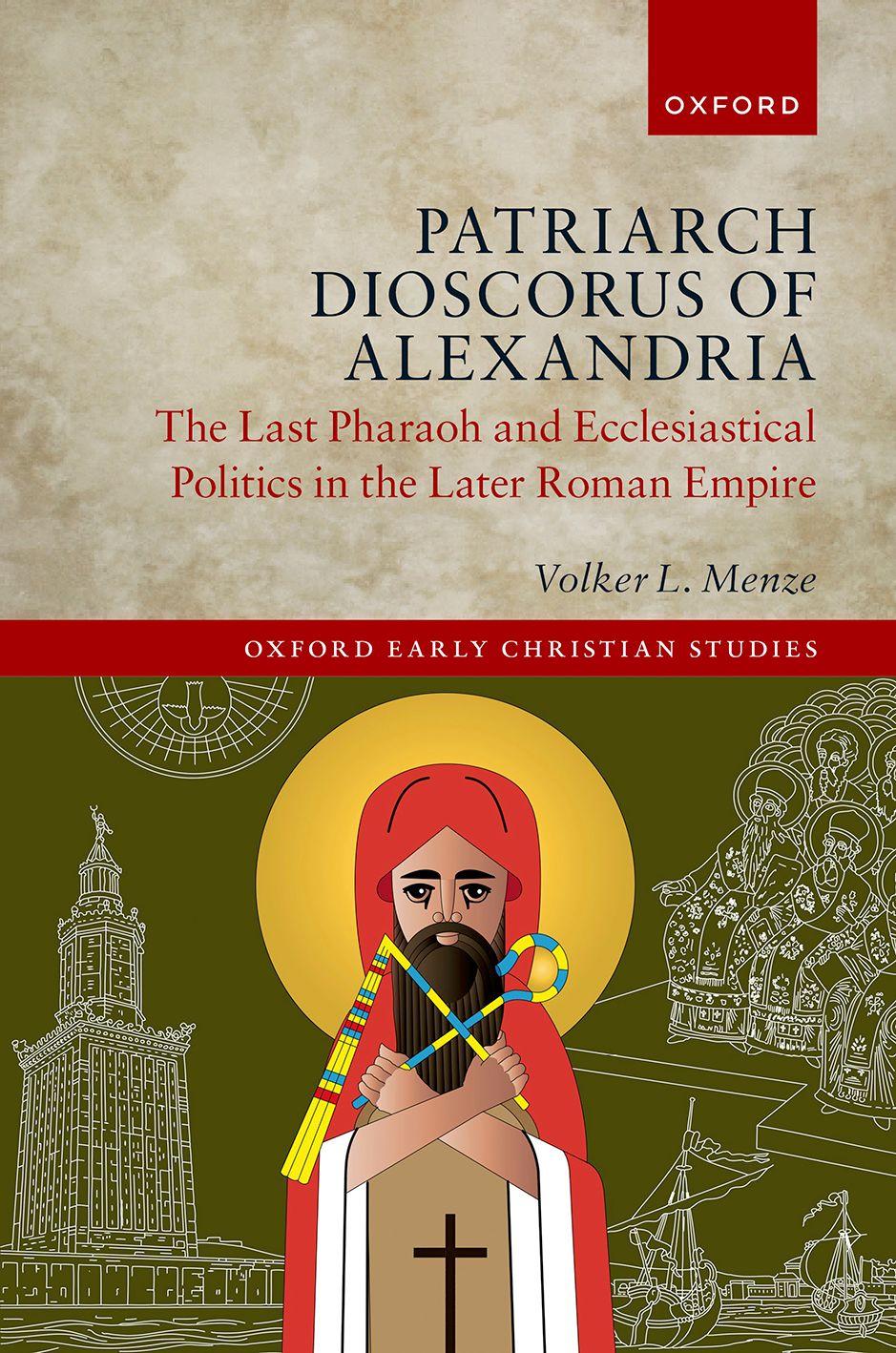Roman Empire Volker L. Menze Visit to download the full and correct content document: https://ebookmass.com/product/patriarch-dioscorus-of-alexandria-the-last-pharaoh-an d-ecclesiastical-politics-in-the-later-roman-empire-volker-l-menze/
More products digital (pdf, epub, mobi) instant download maybe you interests ...
Emperors and Usurpers in the Later Roman Empire: Civil War, Panegyric, and the Construction of Legitimacy Adrastos Omissi
https://ebookmass.com/product/emperors-and-usurpers-in-the-laterroman-empire-civil-war-panegyric-and-the-construction-oflegitimacy-adrastos-omissi/
The Colonate in the Roman Empire Boudewijn Sirks
https://ebookmass.com/product/the-colonate-in-the-roman-empireboudewijn-sirks/
Christianity and the History of Violence in the Roman Empire: A Sourcebook Dirk Rohmann
https://ebookmass.com/product/christianity-and-the-history-ofviolence-in-the-roman-empire-a-sourcebook-dirk-rohmann/
The ends of empire : the last colonies revisited Robert Aldrich
https://ebookmass.com/product/the-ends-of-empire-the-lastcolonies-revisited-robert-aldrich/
Medicine and the Law Under the Roman Empire Claire Bubb
https://ebookmass.com/product/medicine-and-the-law-under-theroman-empire-claire-bubb/
Medicine and the Law Under the Roman Empire Claire Bubb
https://ebookmass.com/product/medicine-and-the-law-under-theroman-empire-claire-bubb-2/
The Roman Empire in Crisis, 248-260 Paul N Pearson
https://ebookmass.com/product/the-roman-empire-incrisis-248-260-paul-n-pearson/
The New Roman Empire: A History of Byzantium Anthony Kaldellis
https://ebookmass.com/product/the-new-roman-empire-a-history-ofbyzantium-anthony-kaldellis/
The Bread Makers: The Social and Professional Lives of Bakers in the Western Roman Empire Jared T. Benton
https://ebookmass.com/product/the-bread-makers-the-social-andprofessional-lives-of-bakers-in-the-western-roman-empire-jared-tbenton/
OXFORDEARLYCHRISTIANSTUDIES GeneralEditors GILLIANCLARKANDREWLOUTH THEOXFORDEARLYCHRISTIANSTUDIES SeriesincludesscholarlyvolumesonthethoughtandhistoryoftheearlyChristian centuries.CoveringawiderangeofGreek,Latin,andOrientalsources,thebooksare ofinteresttotheologians,ancienthistorians,andspecialistsintheclassicaland Jewishworlds.
TheMinorProphetsasChristianScriptureintheCommentariesof TheodoreofMopsuestiaandCyrilofAlexandria
HaunaT.Ondrey(2018)
PreachingChristologyintheRomanNearEast
AStudyofJacobofSerugh PhilipMichaelForness(2018)
GodandChristinIrenaeus
AnthonyBriggman(2018)
Augustine’sEarlyThoughtontheRedemptiveFunction ofDivineJudgement
BartvanEgmond(2018)
TheIdeaofNicaeaintheEarlyChurchCouncils, 431–451 MarkS.Smith(2018)
TheManyDeathsofPeterandPaul DavidL.Eastman(2019)
VisionsandFacesoftheTragic TheMimesisofTragedyandtheFollyofSalvation inEarlyChristianLiterature
PaulM.Blowers(2020)
Art,Craft,andTheologyinFourth-CenturyChristianAuthors MorwennaLudlow(2020)
NemesiusofEmesaonHumanNature ACosmopolitanAnthropologyfromRomanSyria DavidLloydDusenbury(2021)
TheConsolationofBoethiusasPoeticLiturgy
StephenBlackwood(2022)
ClementandScripturalExegesis
TheMakingofaCommentarialTheologian H.CliftonWard(2022)
TheCultofStepheninJerusalem InventingaPatronMartyr HugoMéndez(2022)
PatriarchDioscorus ofAlexandria TheLastPharaohandEcclesiasticalPolitics intheLaterRomanEmpire VOLKERL.MENZE GreatClarendonStreet,Oxford,OX26DP, UnitedKingdom
OxfordUniversityPressisadepartmentoftheUniversityofOxford. ItfurtherstheUniversity’sobjectiveofexcellenceinresearch,scholarship, andeducationbypublishingworldwide.Oxfordisaregisteredtrademarkof OxfordUniversityPressintheUKandincertainothercountries
©VolkerL.Menze2023
Themoralrightsoftheauthorhavebeenasserted Allrightsreserved.Nopartofthispublicationmaybereproduced,storedin aretrievalsystem,ortransmitted,inanyformorbyanymeans,withoutthe priorpermissioninwritingofOxfordUniversityPress,orasexpresslypermitted bylaw,bylicenceorundertermsagreedwiththeappropriatereprographics rightsorganization.Enquiriesconcerningreproductionoutsidethescopeofthe aboveshouldbesenttotheRightsDepartment,OxfordUniversityPress,atthe addressabove
Youmustnotcirculatethisworkinanyotherform andyoumustimposethissameconditiononanyacquirer
PublishedintheUnitedStatesofAmericabyOxfordUniversityPress 198MadisonAvenue,NewYork,NY10016,UnitedStatesofAmerica
BritishLibraryCataloguinginPublicationData Dataavailable
LibraryofCongressControlNumber:2022948799
ISBN978–0–19–287133–6
DOI:10.1093/oso/9780192871336.001.0001
PrintedandboundintheUKby TJBooksLimited
LinkstothirdpartywebsitesareprovidedbyOxfordingoodfaithand forinformationonly.Oxforddisclaimsanyresponsibilityforthematerials containedinanythirdpartywebsitereferencedinthiswork.
Acknowledgements Thebookhasbeeninthemakingsince2016andIamgratefultoanumberof peoplewhohelpedmealongtheway.My firstthanksgotothestaffofCEU’ s libraryinBudapestwhothroughoutyearsfaithfullydeliveredeachandeveryILL Ineeded.The firstchapterofthebookstartedtotakeshapein2018duringastay inIstanbulanditowesalottoTudorSala’smeticulouscomments.Iwrotethe first draftsofChapters2and4inBudapestandrevisedthemtogetherwithchapter onecompletelyduringmystayinHamburgin2020–21.Iammuchobligedto SabinePanzramoftheCenterofAdvancedStudies ‘RomanIslam’ inHamburg whomadeEda’sandmystayattheAlstermostpleasantandproductive. MythanksalsogotoKevinGrotherrwhoorganizedandscannedbooksforme duringthis firstCoronayear.
ThecomplexChapter3resistedcompletionseveraltimesbutI finishedit duringspringandsummer2021inMunich.Twoanonymousreadersfrom OxfordUniversityPresshelpedtoshapemyargument,particularly ‘readerone’ whochallengedmetothinkharderincharacterizingmyprotagonistDioscorus. AfterOxfordUniversityPresshadacceptedthetypescriptforpublication,Iasked RichardPriceas the expertontheecumenicalcouncilsinLateAntiquityifhe couldhavealookatmyrevisedversion.Ithenlearnedthathewas ‘readerone’!He kindlyagreedtoreadthewholetypescriptagain,andIamgreatlyindebtedtohim fornumerouscorrectionsandsuggestions.Allremainingmistakesareofcourse myown.
TheresearchsupportingthisbookwaspartlysponsoredbyCentralEuropean UniversityFoundationofBudapest(CEUBPF)andallowedmetohireAnnalisa Zox-WeaverforeditingthetypescriptbeforeIsubmittedittothepublisher.Iam mostgratefultoDavidRockwellwhopainstakinglywentthroughthe finaltypescriptandimpeccablyeditedtextandfootnotes.IalsothankOUP,particularly TomPerridgeandAlexanderHardie-Forsythwhoguidedmybookthroughthe stagesofpublication,aswellastheserieseditorGillianClarkforhernotes.Sona Grigoryan,DieterKorol,ArielLopez,SamuelMoawad,KatharinPapadopoulos, andAndreasWeckwerthatvariousstagesofcompletionprovidedmewith literature,comments,andsuggestions.CankatKaplankindlyagreedtocompile theindex.
Lastbutnotleast,IhavebeensupportedinwritingthisbookbyAnnabellaPal, AndreaPencz-Körmendi,myangelTheodora,andparticularly asalways by
myparents.MyfatherdidnothesitatewhenIaskedhimifyouwoulddesignthe cover:hecreatedthebeautifuliconofDioscorusasPharaohwithAlexandriaand theCouncilofChalcedoninthebackground.Aboveall,mywonderfulwisewife EdahaspatientlylistenedtomyramblingthoughtsaboutDioscorusthroughout thepastyears,andthebookisrightfullydedicatedtoher.
VolkerL.Menze
Antiphellus/Wien Christmas2022
1Cyril’sLegacy:BetweenBankruptcyandSanctity11
2 WindofChange? DioscorusandtheSeeofStMark39
3TheEmperor’sHenchman:Dioscorusandthe ‘Robber-Council’ 89
4The BlackSwan ofChalcedonandDioscorus’ Deposition151 Conclusion:Dioscorus’ AfterlivesasHeretic,Saint,andReformer186
ListofAbbreviations ACC TheActsoftheCouncilofChalcedon. trans.RichardPrice&Michael Gaddis,3vols.[TTH].Liverpool:LiverpoolUniversityPress,2005.
ACO ActaConcilioriumOecumenicorum,ed.EduardSchwartz.Berlin: WalterdeGruyter,1914–82.
CJ CodexIustiniani [CorpusIurisCivilis, vol.2],ed.PaulKrüger.9th–12theds.Berlin:Weidmann,1914–1959.
CouncilofEphesus TheCouncilofEphesusof431:DocumentsandProceedings,trans. RichardPricewithnotesbyThomasGraumann[TTH].Liverpool: LiverpoolUniversityPress,2020.
Coleman-Norton PaulR.Coleman-Norton, RomanState&ChristianChurch:A CollectionofLegalDocumentstoA.D.535,vol.2.London:S.P. C.K.,1966.
CSCO CorpusScriptorumChristianorumOrientalium.Leuven:Peeters,1903–
DOP DumbartonOaksPapers Flemming AktenderEphesinischenSynodevomJahre449,ed.andtrans. JohannesFlemming.Berlin:Weidmann,1917.
NPNF2 NiceneandPost-NiceneFathers,secondseries,ed.PhilipSchaffand HenryWace,14vols.NewYork:ChristianLiteraturePublishing, 1890–1900.
Perry(1875) VelsecundamsynodumEphesinamnecnonexcerpta,quaepraesertim adeampertinentecodicibusSyriacismanuscriptisinMuseo Britannicoasservatis,ed.SamuelG.F.Perry.Oxford:E.PickardHall andJ.H.Stacy,1875.
Perry(1881) TheSecondSynodofEphesustogetherwithcertainextractsrelatingto it.FromSyriacMSS.preservedintheBritishMuseum,trans.Samuel G.F.Perry.Dartford:TheOrientPress,1881.
PG PatrologiaGraeca,ed.Jacques-PaulMigne.Paris:n.p.,1857–66.
PL PatrologiaLatina,ed.Jacques-PaulMigne.Paris:ApudGarnieri Fratres,1841–55.
PLREII
Martindale,JohnRobert,ArnoldH.M.Jones,andJ.Morris, The ProsopographyoftheLaterRomanEmpirevol.2:A.D.395–527. Cambridge:CambridgeUniversityPress,1980.
PO PatrologiaOrientalis, Paris:1904–.
TTH TranslatedTextsforHistorians.Liverpool:LiverpoolUniversity Press,1988–.
Introduction AWorldwithoutChalcedon?
TheodosiusIIwasthelongestrulingemperorofthe(eastern)RomanEmpire.He wasacclaimedassolerulerinConstantinoplein408andruledforthenextfortytwoyears.Whilehisrulewasextensive,hislifewasnot;hediedbyaccidenton28 July450,aged49.¹Intheweeksfollowinghisdemise,hissisterPulcheriamarried the domesticus Marcian,whoascendedthethroneon25August450.Althoughthe newemperorwasamilitaryman,oneofhis firstconcernswastheconvocationof ageneralcouncil.InhislettertoPopeLeo(440–461),inwhichheannounceshis ascension,Marciansuggestssummoningageneralcouncilinwhichthepope shouldtakethelead.²Thepopeat firstignoredMarcian’ssuggestion,³butthe emperorpersisted,andtheAugustaPulcheriasoughttopersuadethepopeas well.⁴ Theimperialcouplewantedthiscounciltotakeplace;but,on23May451, whenMarciansummonedit,hestilllackedLeo’sexplicitsupport.Theemperor wrote:
Therefore,becausecertaindoubtsappeartohavearisenaboutourorthodox religion,asindeedshownbytheletterofLeo,themostGod-belovedbishopof thegloriouscityofRome,thisinparticularhaspleasedourclemencythataholy councilshouldbeconvenedinthecityofNicaeaintheprovinceofBithynia,in orderthat,whenmindsagreeandthewholetruthhasbeeninvestigated,andafter thecessationofthoseexertionswithwhichsomepeoplehavelatelydisturbedthe holyandorthodoxreligion,ourtruefaithmayberecognizedmoreclearlyforall time,sothathenceforththerecanbenodoubtingordisagreement.⁵
MarcianimaginedhimselfanewConstantineandthereforedesignatedNicaeaas a fittinglocationforthiscouncil,justasConstantinehadsummonedthebishops tothe firstecumenicalcouncil126yearsearlier.Whatlaterwascanonizedasthe
¹TheodosiusIIwasbornin401andcrownedasinfantin402.
²Leo, ep. 73; ACO II.3.1,p.17: ‘percelebrandamsynodumteauctore’;seetranslationin ACC,vol.1, pp.92–3anddiscussioninManuelaKeßler, DieReligionspolitikKaiserMarcianus(450–57) (PhDDiss. Goethe-UniversityFrankfurtamMain,2011),pp.46–7.
³Marcian’snextlettertoLeonotedthatLeohadsentdelegatestoMarcian,buttheyobviouslyhad noinstructionstodiscussageneralcouncilwiththeeasternemperor;seeLeo, ep. 76; ACO II.3.1,p.18.
⁴ Leo, epp. 76and77; ACO II.3.1,p.18andII.3.1,pp.18–19.
⁵ ACO II.1.1,pp.27–8;quotefrom ACC, vol.1,pp.98–9.
PatriarchDioscorusofAlexandria:TheLastPharaohandEcclesiasticalPoliticsintheLaterRomanEmpire.VolkerL.Menze, OxfordUniversityPress.©VolkerL.Menze2023.DOI:10.1093/oso/9780192871336.003.0001
CouncilofChalcedon becauseitwastransferredfromNicaeatoChalcedon or thefourthecumenicalcouncil,startedinNicaea.AloisGrillmeier,theGerman JesuitscholarandleadingexpertonthiscouncilanditsChristology,notes:
TheearlyhistoryofchristologicaldoctrinenowreacheditsclimaxattheCouncil ofChalcedon,whichwasheldinOctoberoftheyear451.Itwasthepurposeof thosewhowereresponsibleforthesynodtoputanendtothebitterinternal disputeswhichhadoccupiedtheperiodaftertheCouncilofEphesus.For Ephesushadleftunfulfilledataskwhichbythisstageofdevelopmentwaslong overdue:thatofcreatingadogmaticformulawhichmadeitpossibletoexpress theunityandthedistinctioninChristinclearterms.⁶
UponEmperorMarcian’sinsistence,thecouncilestablishedthisnewformulaof faith(notacreedbuta ὅρος,adefinition)andratifieditinitssixthsession.⁷ Most theologiansagreewithGrillmeieronthestateofChristology,buthistoriansmust disagreewiththedeterminismwithwhichhedepictseventsleadingtothe convocationoftheCouncilofChalcedon.Thisdevelopmentwasbynomeansa given.TheodosiusIIwasnotonlythelongestrulingRomanemperorbutalsothe onlyemperorwhosummonedtwoecumenicalcouncilsinhislifetime:in431and againin449,whenhesummonedbishopstoEphesus.Thecouncilof431wasan organizationaldisaster,astwocouncilsmetseparatelyinEphesus,andmutually condemnedtherespectiveprotagonistsCyrilofAlexandria(412–444)and NestoriusofConstantinople(428–431).EventhoughtheoneorganizedbyCyril waslateracceptedasecumenical,ittooktwoyearsbeforethebishopsofAntioch andAlexandriareachedanagreementtobeincommunionagain.Unrestand resistancetotheagreementcontinuedtounsettletheneareasternprovincesfor thefollowingdecadeandahalf.
Theodosiushadlearnedfromthisconciliarmismanagementwhenhesummonedhissecondecumenicalcouncil.Thistimehegaveclearinstructionsto Dioscorus,thepatriarchofAlexandria(444–451),aspresidentoftheCouncil,to proceedagainstFlavianofConstantinople(446–449),TheodoretofCyrrhus (423–455/60),andother ‘Nestorians’.Dioscorusdeliveredwhattheemperor expectedandproceededagainstall ‘Nestorians’ andopponentsofCyril’ s Christology.ThepatriarchofAlexandriainstalledhisformerambassador(apocrisarius)asthenewbishopofConstantinople,whointurnordainedanewbishop
⁶ AloisGrillmeier, ChristinChristianTraditionvol.1:FromtheApostolicAgetoChalcedon(451), trans.JohnBowden,2nded.(Atlanta:JohnKnoxPress,1975),p.541.MorerecentlyalsoSandra Leuenberger-Wenger, DasKonzilvonChalcedonunddieKirche:KonflikteundNormierungsprozesseim 5.und6.Jahrhundert (Leiden:Brill,2019),p.2speaksofa ‘Kulminationspunkt’ .
⁷ GrillmeieralsonotedthattheCouncildidnot findgeneralacceptance,andalargepartofhislater oeuvreisdedicatedtothetheologicaldissentionsthatechoedthroughoutthefollowingcentury.
ofAntioch.Inshort,harmonywasrestoredbetweenthemajoreasternsees,and theemperorhopedthat, finally,the ‘Nestorianheresy’ hadbeen ‘excised’ .
TheodosiusconsideredtheSecondCouncilofEphesustobethethirdecumenicalcouncilanddefendeditagainstallappealsfromtheWest:threeletterstothe westernEmperorValentinianIII(425–455),hismotherGallaPlacidia,andLicinia Eudoxia,Valentinian’swifeanddaughterofTheodosius,respectively,survive fromthe firsthalfof450.Intheseletters,TheodosiusmentionstheSecond CouncilofEphesustogetherwithNicaeaandtheFirstCouncilofEphesus, informinghisaddresseesthathewaspleasedwiththeoutcomeandthatno otherdecisionwouldhavebeenpossible. ⁸ Onlyafewmonthslater,though, Theodosiusdiedunexpectedly:hefelloffhishorseon26July450,andsuccumbed tohisspinalinjurieswithintwodays.⁹ Iftheemperorhadstayedathomethatday insteadofriding,theCouncilofChalcedonwouldhavenevertakenplace.Papal protestsagainstthecouncilmighthavecausedaschismbetweenRomeand Constantinople,liketheAcacianschismafewdecadeslater,butthepopehardly hadenoughpowertoreversedecisionsofanecumenicalcouncilintheEastonhis own.¹⁰
Grillmeierandother(Western)theologiansmaybecorrectthatChristology reacheditsapexwiththeCouncilofChalcedon,butatheologicalapproachis unsatisfactoryforthehistorian,inasmuchasitfailstotakeintoaccount(ecclesiastical)politicsandtheproblemofcontingencyinhistory.Indeed,historians shouldtakepauseandnotsimplyacceptdevelopmentsasagiven.Historiansmust analysethecausalities.Againsthistoricaldeterminismandtheologicalassertions ofChalcedon’sachievementsforthedoctrineoftheChurchinthelongrun,the historianmuststressthat,nonetheless,inthe firsthalfof450,contemporaries wouldhavefounditinconceivablethattherewouldbean(other)ecumenical councilanytimesoon.Towit,asGeorgeBevanargues:
Historiansofthisperiod,bothancientandmodern,havebeenalltooreadyto accepttheevolutionaryschemathatseesthetriumphofthe ‘twonatures’ asthe standardoforthodoxyasfundamentallyright.WhenTheodosiusdieditwasfar fromcertainthatthe ‘twonatures’ wouldeverbeadopted.Thatiteverwaswas theresultlargelyofsecular,notreligiousconcerns.¹¹
⁸ SeeChapter3,p.141.
⁹ ThesourcesdifferonwhetherTheodosiusdiedthesamedayoruptotwodayslater;foradetailed overviewofthesourcesseeRichardW.Burgess, ‘TheAccessionofMarcianintheLightofChalcedonian ApologeticandMonophysitePolemic’ , ByzantinischeZeitschrift 86–87(1994):pp.47–68,here48–9and 61–2.
¹
⁰ Anypotentialcouncilheldafewdecadeslaterwouldnothavedaredtoreversethedecisionsofthe SecondCouncilofEphesusbecauseofitsimpactthecouncilhadmadebythispointonChurchand state.
¹¹GeorgeA.Bevan, TheNewJudas:TheCaseofNestoriusinEcclesiasticalPolitics,428–451CE (Leuven:Peeters,2016),p.315.
Thelastecumenicalcouncilhadjusttakenplaceafewmonthspreviously,anda councillikeChalcedonthatannulledthepreviousecumenicalcouncilwasthe mostunlikelyeventpossible a BlackSwan oflateantiqueecclesiasticalhistory.¹²
Thetwoconclusionsdrawnfromthissketchyoutlinearesimplebutshould sufficetoexplainthepremisesonwhichthisbookiswritten:
(a)Historianscannotlookatthisecclesiasticalcontroversyfromitsend.The CouncilofChalcedonindeedhadagreatimpactonthehistoryof Christiandoctrine,butitsgenesiswasduetoanaccident,notbecause therewereunfulfilledChristologicaltasksthatonlyChalcedonwasdeterminedand/orabletoaccomplish.
(b)MostscholarswhostudytheCouncilofChalcedonpointtothetheologicalcontroversyandtheopposingChristologicalunderstandings. WhileChristologyiscertainlyacrucialingredientoftheChristiandiscourseinthe fifthcentury,thisbookwillarguethatpoliticsismore relevantthantheologytounderstandingthecausalityofeventsleading uptotheCouncilanditsdenouement.
PatriarchDioscorusofAlexandria:TheLastPharaohandEcclesiasticalPolitics intheLaterRomanEmpire thereforediscussesdevelopmentsoftheChurch (includingdoctrineandtheology)aspartoflateantiquepoliticalhistory.It therebyseekstoelucidatethemotivesandactionsofsomeoftheecclesiastical protagonistsofthetime particularlyPatriarchDioscorus.Individualperspectivesareofcoursedifficulttoreconstructbecauseourevidenceislimited,but personaldecisionsoftheprotagonistsgreatlyinfluencedthedevelopmentof ecclesiasticalhistory.Whenitcomesto ‘ecumenical’ councils,itneedstobe stressedthatacouncilconvenedbytheemperorwaspoliticalbydefault.Inthe longrun,theformulaoffaithdecideduponbysuchacouncilestablished orthodoxyfortheChurch(es),butforthebishopsattending,politicswerewhat matteredforthefutureoftheirsee.Thebookisastudyofpoliticalchurchhistory, aslateantiquebishopshadtobepoliticiansiftheywantedtheirtheologyto prevail.
WhyDioscorus? InhissynodicalletterfromFebruary591tothepatriarchsofConstantinople, Alexandria,Antioch,andJerusalem(aswellastheex-patriarchofAntioch),Pope
¹²NassimNicholasTaleb, TheBlackSwan.TheImpactoftheHighlyImprobable (London:Allen Lane,2007).SeeChapter4,p.183.
GregorytheGreat(590–604)setforthhisprofessionoffaithandunderstandingof orthodoxy:
Itakeupandveneratethefourcouncils,justlikethefourbooksoftheHoly Gospel,thatistosaytheNicenecouncil,whereintheperversedoctrineofAriusis destroyed,thatofConstantinoplealso,whereintheerrorofEunomiusand Macedoniusisrefuted,the firstofEphesusalso,whereintheimpietyof Nestoriusisjudged,andthatofChalcedon,whereinthedepravityofEutyches andDioscorusarereproved.¹³
Nothinginhisstatementsissurprising,presentingasitdoesastandardformula foraChalcedonianChristianinthesixthcentury.Itreferstotheacceptedfour ecumenicalcouncils¹⁴ aswellastothehereticscondemnedbythesecouncils.But whileEutyches,anarchimandritefromConstantinople,hadindeedbeencondemned,¹⁵ Dioscorus pairedherewithEutyches isadifferentmatter.At Chalcedon,hewasheldresponsiblebythemajoritypartyforafancifulbouquet ofmisdeeds,butthecouncilonlydeposedhimwithoutpassingjudgingonhis faith.
Nevertheless,Dioscoruswasregardedasa ‘heretic’ immediatelyafterthe CouncilofChalcedonended.InaletterfromJanuary452,PopeLeonotesto thebishopsofGaulwithsatisfactionthattheCouncilhadfollowedthepapal requestsand ‘hascutofffromGod’sChurchtheseoutrageous fictionswhichare theviewsoftheDevil.Ithascutoffthisabominabledisgraceandlikewise condemnedDioscorusofAlexandriaforhisimpiety,tokeepthatchurchfrom sufferingundeservedcaptivityunderthedominationofaheretic.’¹⁶ Inaletterto TheodoretofCyrrhus,LeocallsDioscorusa ‘asecondPharaoh’ (secundi Pharaonis)andthusensureshiscommemorationasoneofthearchvillainsof Westernchurchhistory.¹⁷
¹³Gregory, ep. I.24; S.GregoriiMagniRegistrumEpistularumLibriI-VII,ed.DagNorberg (Turnhout:Brepols,1982),p.32;translationtakenfrom: TheLettersofGregorytheGreat,trans. JohnR.C.Martyn,vol.1(Toronto:PontificalInstituteofMedievalStudies,2004),p.146;cf.alsohis lettertoqueenTheodelinda,inwhichGregoryprofessedthesamestemmaofcouncilsandheretics/ heresies:Gregory, ep. IV.33; S.GregoriiMagniRegistrumEpistularumLibriI–VII,Norberg,p.253. HereDioscorusisfalselypairedwithNestorius,notwithEutyches.
¹⁴ ThereisnoneedheretodiscusstheecumenicityoftheCouncilofConstantinoplein553inthe LatinWest;PopeGregoryacceptedthataswell.
¹
⁵ EutycheshadbeencondemnedbyalocalsynodinConstantinople448andrestoredtotheChurch byDioscorusattheSecondCouncilofEphesusin449;hiscondemnationof448wastakenforgranted in451.SeeChapter3,pp.98–107and119–21.
¹⁶ Leo, ep. 102; ACO II.4,pp.53–4; St.LeotheGreat:Letters,trans.EdmundHunt(NewYork: FathersoftheChurch,1957),pp.172–6herep.175.
¹⁷ Leo, ep. 120; ACO II.4,pp.78–81,here79;theletterorpartsofithavebeenregardedspurious;see PhilippeBlaudeau, ‘Unarchevêqued’Alexandrieassassin?Retoursuruneincriminationlancéeà l’encontredeDioscore1er’,in ChristianityinEgypt:LiteraryProductionandIntellectualTrends.
Eveninmodernscholarship,pejorativejudgementsofDioscoruspredominate. In1894,AmelliD.Ambrogio,inhisbookonPopeLeo,calledDioscorusthe ‘AttiladellaChiesaOrientale ’.¹⁸ In1926,NormanBaynestookthischaracterizationfurther,concluding: ‘Dioscoros theAttilaoftheEasternChurch,asAmelli hasstyledhim(thoughthissurelyaninsulttoAttila!).’¹⁹ Thesetwoscholarsmay beexceptionalinusingacatchyimagebutnegativejudgementsofDioscorus persistthroughouttwentiethandtwenty-first-centuryscholarship:in1921, EduardSchwartzsawDioscorusasagitatingwith ‘ruthlessbrutality’ (ajudgement largelyacceptedbydeVriesin1975inhisstudyontheSecondCouncilof Ephesus);RichardSellers,inhisbookontheCouncilofChalcedonin1953, regardedhimas ‘oneofthe “violentmen” inthehistoryoftheEarlyChurch’;in 1972WilliamFrend,inhisseminal RiseoftheMonophysiteMovement,pointedto ‘Dioscorus’ tyrannicalconduct’;in2005,RichardPriceandMichaelGaddis judgedhimas ‘ruthlessandambitious’,withthelatterdescribinghiminthe sameyearasanarrogant ‘tyrant-bishop’;CorneliaHornandRobertPhenix attributedtothe ‘fearsome ’ Dioscorusa ‘chaoticvillainy’;andVasilijeVranicin hisstudyonTheodoretofCyrrhusfrom2015,drewapprovinglyuponaquotation from1911thatdescribedDioscorusas ‘violent,rapacious,unscrupulous,and scandalouslyimmoral’.²⁰ Theseareallexcellent someevenground-breaking studiesbyscholarswhoseworksandwordsshouldbetakenseriously.²¹John McGuckin’sstandardstudyonCyrilwarrantsquotingatlength:
StudiesinHonorofTitoOrlandi,ed.AlbertoCamplani(StudieEphemeridisAugustinianum 125) (Rome:Augustinianum,2011),pp.87–100,here94–5.ButDioscoruswasnotthe firstbishopof Alexandriatobecalled ‘pharaoh’;seebelow,p.10.
¹
⁸ GuerrinoAmelli, S.LeoneMagnoel’Oriente (Montecassino:Tipo-LitografiaCassinese,1894), p.8.MorefavourableisAdolfvonHarnack, LehrbuchderDogmengeschichte,2nded.,vol.2(Freiburg: J.C.B.Mohr,1888),pp.370–1,whoregardsDioscorusasaworthysuccessorofAthanasius,nota heretic!
¹
⁹ NormanH.Baynes, ‘AlexandriaandConstantinople:AStudyinEcclesiasticalDiplomacy’ , The JournalofEgyptianArchaeology 12(1926):pp.145–56,here155.
²
⁰ EduardSchwartz, ‘ÜberdieReichskonzilienvonTheodosiusbisJustinian’ , Zeitschriftder Savigny-StiftungfürRechtsgeschichte:KanonistischeAbteilung 42(1921):pp.208–53,here231;see alsoEduardSchwartz, DerProzessdesEutyches (Munich:BayerischeAkademiederWissenschaften 1929),p.54: ‘BrutaleGewaltpolitik’;WilhelmdeVries, ‘DasKonzilvonEphesus449,eine “Räubersynode?”’ , OrientaliaChristianaPeriodica 41(1975):pp.357–98,here363;Richard V.Sellers, TheCouncilofChalcedon:AHistoricalandDoctrinalSurvey (London:SPCK,1953),p.30; W.H.C.Frend, TheRiseoftheMonophysiteMovement:ChaptersintheHistoryoftheChurchinthe FifthandSixthCenturies (Cambridge:CambridgeUniversityPress,1972),p.6; ACC, vol.1,p.30; MichaelGaddis, ThereisnoCrimeforThoseWhoHaveChrist: ReligiousViolenceintheChristian RomanEmpire (Berkeley:UniversityofCaliforniaPress,2005),pp.308–9;CorneliaB.Hornand RobertR.PhenixJrintheirintroductionto JohnRufus:The Lives ofPetertheIberian,Theodosiusof Jerusalem,andtheMonkRomanus (Atlanta:SocietyofBiblicalLiterature,2008),pp.xlvandxlvi; VasilijeVranic, TheConstancyandDevelopmentintheChristologyofTheodoretofCyrrhus (Leiden: Brill,2015),p.57n.167.
²¹PhilipJenkins, JesusWars:HowFourPatriarchs,ThreeQueens,andTwoEmperorsDecidedwhat Christianswouldbelieveforthenext1500Years (NewYork:HarperCollins,2010)andhisthoughton p.210thatDioscorusperhapssufferedfrom ‘somekindofpersonalitydisorder,whichdrovehimto extremesofparanoiaanduncontrollablerage’ shouldbetakenlessseriously.
DioscoruswasdevotedtoCyril’stheologywhichheidentifiedasthesole standardoforthodoxy,thoughwithmuchlesstheologicaljudgment.He regardedallCyril’seffortsofrapprochementwiththeSyriansasthemisguided weaknessofanoldmanwhowassickatthetimePaulofEmesacametodealwith him.HethusdismissedasignificantpartofCyril’stheologysupposedlyinthe nameofCyril.Evenworse,hewasmuchlesspoliticallyskilledthanhismentor. HewouldsoonbringtheAlexandrianchurchintoaruinousdeclinefromwhich itwouldneverre-emergeasthegreatinternationalChristianpowerithadonce been.²²
McGuckinisrightthatDioscoruscontinuedCyril’stheologywithlesspolitical acumen,buthejudgesDioscorusfromtheChalcedonianendofthestory.The lackofdetailedstudiesforthecrucialyears444–451fromanAlexandrian perspectivehasledscholarstomerelyassumeratherthanexamineDioscorus’ statusasanepigoneofCyril.Itisindicativethatscholarshavenotmeditated furtheronwhyandhowDioscorusfailedtobeassuccessfulashispredecessor. WhywerethesentencesoftheSecondCouncilofEphesusabandonedimmediatelyafterthedeathofTheodosius?WasthisbecauseDioscorushadusedphysical violencein449toforcebishopsintoagreement,asmanybishopsatChalcedon wouldgoontoclaimandasmostmodernscholarshaveunquestioningly assumed?IfDioscoruswasanunscrupulous,brutal,andimmoralmanatthe SecondCouncilofEphesusin449,whywouldhewillinglyleaveAlexandriain451 andcometohisowntrialatChalcedonlikesheeptotheslaughter politely acceptingtheimperialrequesttositdownasaculprit?
ThereareafewexceptionstotheprevailingnegativejudgementofDioscorus becauseopponentsoftheCouncilofChalcedonregardedDioscorusasaconfessor offaith.TheCopticChurchinparticularhascommemoratedhimamongtheir saintssincethe fifthandsixthcenturiesuptothepresentday.²³Vilakuvelil C.Samuel,apriestoftheMalankaraOrthodoxSyrianChurch,offersinhis book TheCouncilofChalcedonRe-Examined arevisionistreadingwithobvious sympathiesforDioscorus(‘DioscoruswasfairertoLeothanthelattertothe former’²⁴),which,despiteitsmerits,asanevaluationcannotcompletelysatisfy historians.Asimilarperceptioncanbefoundintheonlyexistingmonographon Dioscorus:KaramKhella’s1963dissertationentitled DioskorosI.von
²²JohnMcGuckin, SaintCyrilofAlexandriaandtheChristologicalControversy:ItsHistory, Theology,andTexts (Leiden:Brill,1994),p.124.
²³SeeforexampleJacobN.Ghaly, ‘St.DioscorusofAlexandria:ACopticOrthodoxPerspective’ , St.NersessTheologicalReview 3(1998):pp.45–53,whichdoesnot,however,offerascholarlyreview. TheArmenianChurchhasamorecomplicatedhistorywhenitcomestoDioscorus.Krikor Maksoudian, ‘ReconciliationofMemories:TheMalignedDioscorus’ , St.NersessTheologicalReview 3(1998):pp.78–94.
²⁴ VilakuvelilCherianSamuel, TheCouncilofChalcedonRe-Examined:AHistoricalandTheological Survey (Madras:TheDiocesanPress,1977),p.70.
Alexandrien.TheologieundKirchenpolitik.Themanuscriptwasleftunpublished afteritssubmissionbutconsiderablepartsofitwerepublishedasacontributionto abookon DieKopten inthe1980s.²⁵ Thedissertationwasprintedforthe firsttime infullbutwithoutanyrevisionsorupdatesin2017.Itisascholarly flawedstudy withnumerousmistakesandanuncriticaltreatmentofsources.²⁶
TheonlycriticalworksonDioscorusthatarenotcondemnatoryareFelix Haase, ‘PatriarchDioskurI.vonAlexandria.NachmonophysitischenQuellen’ from1908,andOttoSeeck,inhis GeschichtedesUntergangsderAntikenWelt (1920),whocharacterizedDioscorus(attheCouncilofChalcedonin451)as ‘the soleman’ among ‘howlingcrones’ who ‘foughthis fightofdesperation’,aswellasa studybyGeoffreydeSte.Croix,whocreditedDioscoruswith ‘ courage ’.²⁷ Notably, inrecentyears,afewstudiesonDioscorus’‘oriental’ sourceshaveputour knowledgeon firmerfooting.SamuelMoawad’sworks,inparticular,arelandmarksfortheoriginsoftheCoptic,Syriac,andArabictextsonDioscorus,but thesestudiesareconcernedwiththelaterecclesiasticaltraditionsandnotwiththe historicalDioscorusortheChristologicalandecclesiasticalcontroversiesofthe fifthcentury.²⁸
AnothergapinthescholarshiponDioscorusisthelackofhistoricalstudieson theCouncilofChalcedonandtheSecondCouncilofEphesus.Thelatterwould needathoroughintroductorystudy,whichcannotbeprovidedinthesepages.²⁹ ThereisnolackofstudiesonChalcedoningeneralbutonlyrecentlyhave historiansstartedtoimmersethemselvesintodetailedtreatmentofthecouncil.³⁰
²
⁵ KaramKhella, DioskorosIvonAlexandrien:TheologieundKirchenpolitik,(Diss.Kiel,1963/68); printedwithoutdiscussionofsources,bibliographyandthechapteronthetheologyofDioscorusin: DieKopten, ed.KoptischeGemeindee.V,vol.2(Hamburg,[nopublisher],1981),pp.9–282and reprintedinfullas DioskorosIvonAlexandrien:TheologieundKirchenpolitik (Hamburg:Verlag TheorieundPraxis,[2017]).
²
⁶ Seemyreviewin sehepunkte 19(2019):http://www.sehepunkte.de/2019/09/32538.html.
²⁷ FelixHaase, ‘PatriarchDioskurI.vonAlexandria.NachmonophysitischenQuellen’ , KirchengeschichtlicheAbhandlungen 6(1908):pp.141–233:mostofhisanalysisandinterpretation, however,isdated;OttoSeeck, GeschichtedesUntergangsderantikenWelt, vol.6(Stuttgart:Metzler, 1920),p.274: ‘Dereinzige,dersichindieserGesellschaftvonheulendenaltenWeibernalsMannerweist, istDioscorus;dieseraberkämpfteeinenKampfderVerzweiflungundwussteganzgenau,dass,auch wennersichduckte,wiedieübrigen,esfürihnkeineGnadegab.Trotzdemistesbewundernswert,wieer, vonallenFreundenverlassenundbeijedemWorte,dasersagt,vonderganzenBandeangebrüllt,doch seinekühneHaltungzubewahrenweiss.’ G.E.M.deSte.Croix, ‘TheCouncilofChalcedon’,in ChristianPersecution,Martyrdom,andOrthodoxy,ed.MichaelWhitbyandJosephStreeter(Oxford: OxfordUniversityPress,2006),pp.259–319,here314–15.
²⁸ The firsttostudyDioscorusbasedonthe ‘oriental’ sourceswasofcourseHaase, ‘Patriarch DioskurI.vonAlexandria.NachmonophysitischenQuellen’ butseenow:SamuelMoawad, UntersuchungenzumPanegyrikosaufMakariosvonTkōouundzuseinerÜberlieferung (Wiesbaden; Reichert,2010); DieArabischeVersionder VitaDioscori,ed.andtrans.SamuelMoawad[PO 246] (Turnhout:Brepols,2016),andfurtherarticles.
²⁹ Areviewofthemanuscriptisneeded,aswellasaninquiryintothequestionsofwhotookthe minutes,howweretheytranslated,thenumberofsessions,etc.
³
⁰ InrecentyearsafewhistorianshavepickeduponChalcedon;seeFergusMillar, AGreekRoman Empire:PowerandBeliefunderTheodosiusII(408–450) (Berkeley:UniversityofCaliforniaPress,2006) andRamsayMacMullen, VotingaboutGodinEarlyChurchCouncils (NewHaven:YaleUniversity
Moststudiesthereforefailtoaddresshistoricalquestionsofhowtounderstand theCouncilofChalcedon,includingthemotivesandstrategiesofthedifferent protagonistsandsoforth.Thepresentbookattemptstoreconstructthehistorical Dioscorusasapreeminentecclesiasticalpoliticianofthe fifthcenturybasedonthe survivingevidenceandhisconflictingcommemorations.Whilesourcesarenot abundantenoughtowriteafullbiography,sufficienttextualevidencesurviveto allowforreconstructingpartsofhiscareerandendeavoursaspatriarchandplace himwithintheecclesiasticalhistoryofAlexandria,theinfluenceofwhichpeaked underhisleadershipin449–50.
Dioscoruscannot,however,befullyunderstoodwithoutregardtothepolitics ofhispredecessor.NotonlyisCyril’stenurebetterdocumentedbutitalsosetsthe stageforsubsequentAlexandrianecclesiasticalpolitics.Cyrilwasashrewdpoliticianwhopushedthroughhisagendaagainstallodds.Hisactionsprovokednot onlyresistanceinConstantinopleandtheeasterndiocesesbutalsounrestamong hisownclergy.ItisthisbackdropagainstwhichDioscorusasCyril’sheiracted, andthereforethe firstchapterofthisbookfocusesonCyril’secclesiasticalpolitics andthelegacyhelefttoDioscorus.Morebroadly,thegoalofthisbookisto introduceDioscorusasmajorprotagonistinhisownrightandtoshowthat,while Dioscoruswasa ‘Cyrillian’ theologically,hewasan ‘anti-Cyrillian ’ politically,one whobrokewiththeCyrillianadministrationattheSeeofAlexandriaand improvedecclesiasticalgovernanceoftheAlexandrianchapter.ThisbookmaintainsthatDioscorusdidnotactivelyengageintheChristologicalcontroversy before448butwasdraggedintothesequarrelsbelatedly.Incontrasttoscholarly consensus,thisstudyalsoshowsthatDioscoruswasnotthemastermindbehind theSecondCouncilofEphesusbuttheemperor’shenchman.
AtthesametimeDioscorus’ speedydownfallmustbeexplained:howcouldhe havebeenacclaimedas ‘universalarchbishop’ inAugust449onlytobedeposed twoyearslater?TheCouncilofChalcedonwasinalllikelihoodnotplannedby EmperorMarcianasacompleteturnofevents.Theemperorintendedtobring aboutareconciliationwithRomeandactivelyshapedanewpositionfortheSeeof Constantinople,butnothingindicatesthathewantedDioscorustobeaccusedand exiled.Further,Dioscoruswasdeposedfromofficebutnotcondemnedforheresy atChalcedon.AlthoughthisshouldbeobviousfromtheactsofChalcedon,this misconceptioncanstillbefoundinstandardhandbooks.³¹Finally,Dioscorusis wronglysingledoutbyscholarsasabrutalvillainandpower-hungrypolitician, Press,2006).SeealsoHagitAmirav, AuthorityandPerformance:SociologicalPerspectivesonthe CouncilofChalcedon(AD451) (Göttingen:Vandenhoeck&Ruprecht,2015);Leuenberger-Wenger, DasKonzilvonChalcedon
³¹SeeforexampleAngelodiBernardino, Patrology:TheEasternFathersfromtheCouncilof Chalcedon(451)toJohnofDamascus(750),trans.AdrianWalford(Cambridge:JamesClark,2006), p.335: ‘WiththeCouncilofChalcedon(451)thebishopricofAlexandrialostprestigeasthetraditional strongholdoforthodoxy,sinceatthatcounciltheAlexandrianbishopDioscoruswascondemnedfor heresy.’
whenhewas,infact,anableadministratorandecclesiasticalreformerevenifhe waspoliticallylessshrewdthanhispredecessorand,sofarasonecandiscern, lackedanygreaterecclesiasticalvision.Aspoliticsdrovetheecclesiasticaland conciliardevelopmentatleastasmuchastheology,thiswasahandicapthatcost Dioscorushissee.
Mybook PatriarchDioscorusofAlexandria thusoffersno finalreadingofthe SecondCouncilofEphesusortheCouncilofChalcedonbutitishopedthatit offersanewperspectiveonthiscrucialperiodofancientecclesiasticaldevelopmentandarevisionoftraditionalaccountsofChurchHistorythataremore drivenbytheologythanpolitics.Itusesthesourcesasitsstartingpointanddoes nottakeanymoderninterpretationforgranted.ThisperspectiveofDioscoruswill raiserelevantquestions questionstowhichmyanswers(whichoftenremain conjectural)willinvitesound contradictiones byhistoriansandtheologiansalike. IamalltooawarethatIwasunabletoread,include,anddiscussallofthe literaturethatscholarshavewrittenonthe ‘NestorianControversy’ andthe CouncilofChalcedon,butIhopetohaveaccountedforandnotedthemost relevantdiscussionsinthestudythatfollows.
Anoteaboutconventions:thebishopsofRomewillbecalled ‘ popes ’,and Dioscorusandsomeotherbishopsofthelaterpatriarchalseesintheeastern Mediterranean ‘patriarchs’.³²Also,Iusetheterm ‘ecumenical’ forgeneralcouncils convenedbytheemperor;thisincludesbydefinitiontheSecondCouncilof Ephesus.Finally,thesubtitle, ‘TheLastPharaoh’,makesuseofpejorativecommentsagainstthebishopsofAlexandriabylateantiquecontemporaries:foremost ofcoursebyLeoagainstDioscorusbutitisalsosaidthatJohnChrysostomas bishopofConstantinoplecomparedDioscorus’ predecessorTheophilus (385–412)tothepharaonicrulers.³³Withoutagreeingwiththederogativenotion ofthisepithet,itmakesacatchytitle,andthedominanceoftheSeeofAlexandria throughouttheeasternMediterraneandidendwithDioscorus who,inthis sense,canberegardedthelast ‘pharaoh’,andperhapsforashortperiodalsothe mostpowerfulpatriarchthatAlexandriaeversaw.
³²SeealsoChapter1,p.13.
³³Sozomen, ChurchHistory VIII.18; Sozomenos:HistoriaEcclesiastica.Kirchengeschichte,ed.and trans.GüntherChristianHansen,vol.4(Turnhout:Brepols,2004),pp.1016–17.
Cyril’sLegacy BetweenBankruptcyandSanctity Introduction EduardSchwartzremainsbestknownformagisteriallyeditingthe fifth-century actsoftheEcumenicalCouncils,the ActaConciliorumOecumenicorum.Healso publishednumerousarticlesandstudiesonancientChurchHistory,thesources ofwhichheknewbetterthananyoneelse.Hisjudgementconcerningthebishops ofAlexandriaandhischaracterizationofthemasrulerswasharsh:
Thisrule,establishedintheseclusionofthelandoftheNilebydomineering characters(‘Herrschernaturen’)createdawillforpowerwhichdidnotrestuntilit subduedtheimperialChurchatleastoftheeasternpart[oftheempire].Never hastheworldencounteredmoreruthlesshierarchsthanthosemenwhosaton thethroneofStMarkintheperiodfromthegreatpersecutiontotheCouncilof Chalcedon.Theyusedallpoliticalmeansunscrupulously,cunningandviolence, bribeandintrigue,andespeciallypartisanpublishing(‘Publizistik’)which as writingmonotonousandgraceless wasanachievementofthe firstrankin termsofitssuccess.¹
Inhisstudy,SchwartzpointstoAthanasius(328–373),Theophilus(385–412), Cyril(412–444),andDioscorus(444–451),allofwhomnotonlyweremajor ecclesiasticalprotagonistsinEgyptbutalsoinfluencedChristianityatlargeinone wayoranother.SamuelRubensonnotesthat,duringhislongtenure,Athanasius established ‘apositionforhisofficethatcouldnotbeneglectedbyanyemperoror council’,andthatbythetimehedied, ‘thepositionasarchbishopofAlexandria hadbecomeacentreofpoliticalandeconomicpowerofitsown’.²Theophilus remainsknowninhistoryforthedestructionofthepaganSerapeumin
¹EduardSchwartz, ‘ÜberdieReichskonzilienvonTheodosiusbisJustinian’ , ZeitschriftderSavignyStiftungfürRechtsgeschichte:KanonistischeAbteilung 42(1921):pp.208–53,here215.
²SamuelRubenson, ‘FromSchooltoPatriarchate:AspectsontheChristianisationofAlexandria’,in Alexandria.ACulturalandReligiousMeltingPot,ed.GeorgeHingeandJensA.Krasilnikoff(Aarhus: AarhusUniversityPress,2009),pp.144–57,here152–3.Evenuntilthetwentiethcentury,Athanasius’ writingsdominatedtheperceptionofthefourthcentury,particularlythroughhisfashioningof ‘Arianism’ .
PatriarchDioscorusofAlexandria:TheLastPharaohandEcclesiasticalPoliticsintheLaterRomanEmpire.VolkerL.Menze, OxfordUniversityPress.©VolkerL.Menze2023.DOI:10.1093/oso/9780192871336.003.0002
AlexandriabuthealsoplayedanactiveroleinecclesiasticalaffairsoutsideEgypt. HeactivelyinterferedinecclesiasticalpoliticsinConstantinopleandwasresponsiblefortheremovalofJohnChrysostom(398–405)asbishopoftheeastern capital.NormanBaynesremarksthat:
whentherelentlessbrutalityofTheophilus,thefoeofChrysostom,hadwith fire andswordstampedouttheoppositionoftheNitrianmonks,therewasnofurther roomforindependenceofthoughtinEgypt;nodeclarationofpapalinfallibility wasneeded:theinfallibilityofthePapaofAlexandriawasforEgyptanaxiom.The patriarchwas fightinghiscountry’sbattles,andhisdespotismwasunchallenged.³
Nevertheless,Alexandria’secclesiasticalinfluenceintheeasternMediterranean increasedevenfurtherafterhisdeathandclimaxedunderTheophilus’ nephewCyril. Cyriltookovertheepiscopatefromhisunclewiththehelpofthemilitary, accordingtotheChurchhistorianSocrates,acontemporaryofCyril.Socrates claimedthat ‘Cyrilcameintopossessionoftheepiscopate,withgreaterpower thanTheophilushadeverexercised.Forfromthattimethebishopricof Alexandriawentbeyondthelimitsofitssacerdotalfunctions,andassumedthe administrationofsecularmatters.’⁴ Socrates’ depictionofCyrilasapowerconsciouspoliticianhasnegativelyinfluencedCyril’sreceptioninmodernscholarship,compellingJohnMcGuckintoassertthat ‘CyrilofAlexandriahasbeenthe victimofagooddealofEuropeanscholarlymyopiainrecentcenturies;mostofit withunacknowledgedimperialistattitudes,andsomeofitnotfreeofitsownkinds ofracistagenda.’⁵ ThisisnottheplaceforareviewofscholarshiponCyrilbutit seemsthatscholarsoften atleastimplicitly separateCyrilthetheologianfrom Cyrilthepolitician.⁶ SomescholarsregardCyrilasarguablythe ‘greatesteastern theologian’ , ⁷ whodeservestobeadmiredforhistheologicalskillsandhisdedication toorthodoxybutrefusetoacceptthat,asbishop,hewasverymuchinvolvedinthe murkybusinessofpoliticsandfarremovedfromtheotherworldlinessofasaint.⁸
³NormanH.Baynes, ‘AlexandriaandConstantinople:AStudyinEcclesiasticalDiplomacy’ , The JournalofEgyptianArchaeology 12(1926):pp.145–56,here148.
⁴ Socrates, ChurchHistory VII.7; Sokrates:Kirchengeschichte,ed.GüntherChristianHansen(Berlin: Akademie,1995),p.353.Translationtakenfrom NPNF2 vol.2,p.156.
⁵ JohnMcGuckin, ‘CyrilofAlexandria:BishopandPastor’,in StCyrilofAlexandria:ACritical Appreciation,ed.ThomasG.WeinandyandDanielA.Keating(London:T&TClark,2003), pp.205–36,here205.SeealsoPaulineAllen, ‘StCyril,BishopofAlexandria,andPastoralCare’,in AlexandrianLegacy:ACriticalAppraisal,ed.DoruCostache,PhilipKariatlis,andMarioBaghos (NewcastleuponTyne:CambridgeScholarsPublishing,2015),pp.228–45,here231,withfurther scholarship.
⁶ Andfurtherless-studiedcategorieslikeCyrilaspastoralcarer,etc.
⁷ MichaelWhitby, ‘TheChurchHistoriansandChalcedon’,in GreekandRomanHistoriographyin LateAntiquity:FourthtoSixthCenturyA.D., ed.GabrieleMarasco(Leiden:Brill,2003),pp.449–95, here449.
⁸ MarioBaghos, ‘EcclesiasticalMemoryandSecularHistoryintheConflictingRepresentationsof StCyrilofAlexandria’,in AlexandrianLegacy:ACriticalAppraisal,ed.DoruCostache,PhilipKariatlis, andMarioBaghos(NewcastleuponTyne:CambridgeScholarsPublishing,2015),pp.246–80isa
WithintheframeworkoftheLaterRomanEmpire,anyepiscopalofficewasof necessityapoliticaloffice.Thefollowingdiscussionthereforetakesforgranted that,foralateantiquebishop,theologyandpoliticsarenotopposingormutually exclusivecategoriesbutrathercomplementaryskills.⁹ Indeed,abishopshouldbe notonlyacompetenttheologianbutalsoabletocommunicatehistheologytohis flock,hiscity,hisdioceseand inthecaseofthebishopofAlexandria thecourt andtheempire.BeingbishopofAlexandriabrought,bydefault,majorresponsibilitiesthatexceededthestrictlyecclesiasticalrealm,andthereisnoreasonto arguewithSocrates’ assertionthatCyrilhadinfluencefarbeyondhisimmediate ecclesiasticalsphere.Inthesepages,astheintroductionnotes,theterm ‘patriarch’ is usedforthebishopofAlexandria,eventhoughpatriarchalseesbecameonly establishedaftertheCouncilofChalcedon451,asthebishopofAlexandriaalready wieldeddefactopatriarchalinfluenceinthetimeofCyril.LateantiqueChristiansin EgyptprobablyregardedthepatriarchofAlexandriaastheirruler,onewhowas morepowerfulthantheRomangovernorofEgypt.¹⁰ Cyrilistheprimeexampleofa theologicallyversedpatriarch and ablepoliticianwhoensured,withallmeansathis disposal,thathisecclesiasticalpoliticswould findareceptiveearatthecourtof Constantinople.¹¹Inthelongrun,thesetalentsbroughthimsainthoodinthe CatholicandOrthodoxtraditions,butintheshortrunitposednumerousproblems tohissuccessor,Dioscorus,whenthelatterbecamepatriarchin444.
TheAftermathoftheCouncilofEphesus(431) Thecouncilthatwouldlaterberememberedasthethirdecumenicalcouncilfailed miserably.EmperorTheodosiusdecidedtosummonageneralcounciltoEphesus inthesummerof431afterNestorius,thebishopofConstantinople(428–431), hadbeenattackedbyCyrilofAlexandria(412–444)fornotallowingtheVirgin Marytobecalled theotokos inchurch.¹²Cyrilarrivedearlierthantheeastern ratherodd ‘defence’ ofCyril,whileKarlheinzDescher, KriminalgeschichtedesChristentumsvol.2:Die Spätantike,5thed.(Hamburg:Rowohlt,2013)takespleasureineachandeveryscandalthatthesources provide.
⁹ ChristophMarkschies, ‘DiepolitischeDimensiondesBischofsamtesimviertenJahrhundert’,in Recht Macht Gerechtigkeit, ed.JoachimMehlhausen(Gütersloh:GütersloherVerlagshaus,1998), pp.438–69,here451–5,referringtofourth-centurybishopsbutalsomentioningCyril,prefersto speakof ‘kirchenpolitischerSouverän’ ratherthan ‘Kirchenpolitiker’.Evenwhenbishopsclaimedto takeupthe causaDei,however,theycouldnotescapethesphereofworldlypolitics.Foradefinitionof ecclesiasticalpolitics(‘Kirchenpolitik’),seeJoachimMehlhausen, ‘Kirchenpolitik:Erwägungenzueinem undeutlichenWort’ , ZeitschriftfürTheologieundKirche 85,no.3(1988):pp.275–302.
¹⁰ SeethestoryofhowTheophilusofAlexandriaisgreetedaskingofthecountryandthevicarof God: DerPapyruscodexsaecVI–VIIderPhillippsbibliothekinCheltenham:Koptischetheologische Schriften,ed.andtrans.WalterE.Crum(Straßburg:KarlJ.Trübner,1915),p.13(p.67).
¹¹ForotherpoliticalrolesofthepatriarchsofAlexandria liketheanti-paganleadershipof Theophilus,seeEdwardJ.Watts, RiotinAlexandria.TraditionandGroupDynamicsinLateAntique PaganandChristianCommunities (Berkeley:UniversityofCaliforniaPress,2010),pp.157–253.
¹²SeemostrecentlyGeorgeA.Bevan, TheNewJudas:TheCaseofNestoriusinEcclesiasticalPolitics, 428–451CE (Leuven:Peeters,2016),whichprovidesthebasisforthefollowingdiscussion.
bishops,gatheredacouncilwithhissupporterson22June431(againstexplicit imperialorders),anddeposedNestoriusandanathematizedhisteachingsbefore JohnofAntiochandtheothereasternbishopsarrived.¹³OncetheEasterners arrivedafewdayslater,theyrefusedtoacceptCyril’sjudgementofNestorius,and heldacounter-council,theso-called conciliabulum,thatdeposedandexcommunicatedCyrilaswellasMemnonofEphesus.ThiswasnothowTheodosiushad imaginedhowhisgeneralcouncilshouldbeconducted,andinthesummerand autumnof431,heattemptedtorectifythesituation.Heconfinedthebishopsto Ephesusinordertoensurethatbothsideswerewillingtocometoanunderstanding.Healsoacceptedthedepositionsbybothsides,hoping invain,asit turnedout thattherestofthebishopswouldunderstandthismoveasthe warningitwasandthusbemoreamenableto findingcommonground.¹⁴
Notalldetailsofthesedeliberationsinthelatesummerandautumnof431can bereconstructedfromthebiasedandpatchysources,butsometangibleresultsare obvious.Nestorius,whosurprisinglyplayednoroleasprotagonistinEphesus, remaineddeposedontheorderofEmperorTheodosius.¹⁵ On25October431,a newbishopofConstantinople,Maximianus,wasordained.¹ ⁶ Hewassupportedby theCyrillianfactionandsentasynodicallettertoCyril.¹ ⁷ Allattemptsatreconciliationbetweenthetwofactions,however,remainedfutile,andTheodosius acceptedthefailureofthecouncilbyallowingthebishopstoreturnhome,likely aroundearlyNovember431.¹⁸ Attheendoftheyear,theecclesiasticalset-upwas showing fissuresbetweentheeasternbishopsaroundJohnofAntioch,ontheone hand,andRome,Alexandria,andConstantinople,ontheother.Theeastern bishopsconsideredCyrildeposed(andseveralofthemregardedhimasan Apollinarianheretic),whileCyrilhaddeposednotonlyNestoriusandcondemned histeachingsbutalsoJohnofAntiochandhisfollowersbecausetheysidedwitha ‘heretic’.CyrilacceptedMaximianusasthenewbishopofConstantinoplewhile theeasternbishopsstillregardedNestoriusasthelawfulbishopofthecapital.
¹³ ACO I.2,p.35;trans.in CouncilofEphesus,p.254.
¹
⁴ LaterTheodosiusalsoinviteddelegationsfrombothsidestoChalcedonfordiscussionswithhim; Bevan, TheNewJudas providesadetailedaccountofthisinhischapters4and5.
¹
⁵ BevanpointsouthowNestoriusnolongerplayedanyrole,andeventheEasternersseemnotto haveconsultedwithhiminEphesus.Apparently,Theodosiushadbeenpersonallydisappointedwith NestoriusandthereforedidnotdefendhimagainstCyril;seeTheodoret, ep. 3a; ThéodoretdeCyr: CorrespondanceIV(Collectionsconciliaires),ed.andtrans.YvanAzéma(Paris:LesÉditionsduCERF, 1998),pp.80–9,here82–3.IrenaeusalsoreportsthatNestorius’ chancesweremeagre;FergusMillar, A GreekRomanEmpire:PowerandBeliefunderTheodosiusII(408–450) (Berkeley:Universityof CaliforniaPress,2006),p.173.
¹⁶ Socrates, EcclesiasticalHistory VII.37; Sokrates:Kirchengeschichte,ed.GüntherChristianHansen (Berlin:Akademie,1995),p.387.
¹
⁷ ACO I.1.3,p.71;Cyrilwrotealengthyreply. ACO I.1.3,p.72.
¹⁸ Cf.Bevan, TheNewJudas,p.195n.189;AdamM.Schor, Theodoret’sPeople:SocialNetworksand ReligiousConflictinLateRomanSyria (Berkeley:UniversityofCaliforniaPress,2011),p.91.
Eachsidehaditslistofdemands:theEasternersrequestedthatCyrilretracthis controversial TwelveChapters, whichratheraggressivelypresentedhisChristological understandingandcausedtheeasternbishops’ resistance.¹⁹ Cyrilexpectedthe easternbishopsnotonlytoaccepttheterm theotokos (whichwasnoobstaclefor theeasterners)butalsotocondemnNestorius.
Severalallegationsof ‘bribery’ stemfromtheperiodintheimmediateaftermath ofEphesus,butoneinstanceofadetailedcatalogueofgiftssentfromAlexandria toConstantinoplewarrantsspecialattention.The comes Irenaeus,afriendandally ofNestoriuswhoaccompaniedNestoriustoEphesus(andwholaterbecame bishopofTyre),publishedapolemicalwork Tragoedia .²⁰ ThisworkisunfortunatelylostbutinthesixthcenturytheRomandeaconRusticustranslatedan abbreviatedaccountofthedocumentsusedbyIrenaeus primarilyletters into Latin,whichsurvivesinthe CollectioCasinensis.²¹Despitetheanti-Cyrillianbias ofthedocumentation,thetextsofferrareinsightsinto fifth-centuryecclesiastical politicsandtheirmechanisms.
Cyril’sGifts: ‘Blessings’ andGoldfortheCourt Threetextsfromthe CollectioCasinensis matterforourpurposes:(a)ashort fragmentofalettertoanunknownrecipient mostlikely,acleric(astherecipient isreferredtoas sanctitate and religiositate);(b)aletterbyCyril’sarchdeacon, Epiphanius,tobishopMaximianusofConstantinople;and(c)thecatalogueof giftsinkindandgoldthataccompaniedEpiphanius’ letterandmusthavebeen drawnupbyEpiphaniusaswell.²²Thecatalogueappearstobeasummarizedcopy ofacargodocumentfortheactualshipment,notanaccountingdocumentofall
¹⁹ The TwelveChapters werewrittenin430andattachedtothethirdlettertoNestorius;Cyril, ep. 17: ACO I.1.1,pp.33–42.Forthe TwelveChapters seebelow,pp.32–35.
²⁰ JohnRobertMartindale,ArnoldH.M.Jones,andJ.Morris, TheProsopographyoftheLater RomanEmpire,vol.2:A.D.395–527 (Cambridge:CambridgeUniversityPress,2006)(hereafter, PLRE II),pp.624–5: ‘Irenaeus2’;seealsoMillar, AGreekRomanEmpire,pp.168–82;seenowalsoWalter F.Beers, ‘“FurnishWhateverisLackingtoTheirAvarice”:ThePaymentProgrammeofCyrilof Alexandria’,in FromConstantinopletotheFrontier:TheCityandtheCities,ed.Nicholas S.M.Matheou,TheofiliKampianaki,andLorenzoM.Bondioli(Leiden:Brill,2016),pp.67–83,here 68–9.ForIrenaeusseeChapter2,p.77andChapter3,p.93.
²¹ ACO I.4, praefatio; CyrilofAlexandria:SelectLetters,ed.andtrans.LionelR.Wickham(Oxford: OxfordUniversityPress,1983),pp.xliii–xlvii;Millar, AGreekRomanEmpire,AppendixA,particularly pp.239–40;FergusMillar, ‘ImperialGovernmentandtheMaintenanceofOrthodoxy:JustinIand IrregularitiesatCyrrhusin520’ , ScriptaClassicaIsraelica 28(2009):pp.117–37,here129–30.
²² ACO I.4,pp.222–5(numbers292,293,and294); St.CyrilofAlexandria:Letters51–110,trans. JohnI.McEnerney(Washington,DC:CatholicUniversityofAmericaPress,1987),pp.147(Letter94), 151–3(Letter96)and188–92(Appendix4);notealsothediscussioninDanielCaner, ‘Towardsa MiraculousEconomy:ChristianGiftsandMaterial “Blessings” inLateAntiquity’ , JournalofEarly ChristianStudies 14,no.3(2006):pp.329–77,here352–3.The firsttodiscusstheseletters endétail was PierreBatiffol, ‘LesPrésentsdeSaintCyrillealaCourdeConstantinople’ , Bulletind’ancienneliterature etd’archéologiechrétiennes 1(1911):pp.247–64;seenowespeciallyBeers, ‘“FurnishWhateveris
thattheChurchofAlexandriasuppliedforCyril’scause.²³Consideringthatthe overallweightofthegoodstogetherwiththegoldmadeuponlyafewtonsof cargo,thegiftswerelikelyshippedallatonce.²⁴
EpiphaniussenttheletterandthelisttoMaximianusjustafterthegiftshad beendispatched.²⁵ Attheendoftheletter,EpiphaniusnotesthatCyrilhadwritten alettertohistrustedclericsinConstantinopleatthesametimeastheshipment leftAlexandria,mostlikelysentbydifferentmailtoalerttheclericsofthearrival ofthegoodsand,probably,toassignthemtasks,aswell.Thecataloguelists seventeentonineteencourtiersandthegiftstheyweretoreceive.Thegiftsare brokendownintwocategories,giftsinkind(textilesandfurniture)andgiftsin gold.Twicetheletternotesthattheformercategoryofgiftsinkindshouldworkas a ‘dooropener’:onecourtierwastoreceivemoregiftsthantheprecedingrecipient inordertoceaseopposingCyril,whileanotherrecipient’sgiftsareintroduced asincentivessothathe ‘shouldthinkinourfavor ’.²⁶ Itseems,therefore,likely thatthetextilesandfurniturewereconsidered ‘customarysuppliantblessings’ (eulogiaeconsuetudinariaesupplices),asthecatalogueatonepointnotes.²⁷ They wereintendedtoestablishamoralobligationfortherecipientstoconsiderCyril’ s causeinmorefavourableterms.²⁸
LackingtoTheirAvarice”’.Seenowalso CouncilofEphesus, pp.568–71.Thelatterwishtoseparate Epiphanius’ letterfromthelist(p.568n.56):asthelistincludesScholasticius,theauthorsarguethatit musthavebeencompiledinAugust –September431becausealetterbyAcaciusofBeroea(see Council ofEphesus, pp.610–13)fromNovember431notesthatScholasticiushaddied.Thisconclusionis, however,faultybecauseEpiphanius ’ letter whichmusthavebeenwrittenafterspring432 marksScholasticiusasrecipientofbribes.PriceandGraumannin CouncilofEphesus arenot consistentinconsideringtheli sttohavebeencompiledinAugust– September431,astheynote thatthelistwassenttobishopMaximianus(p.569n.61).ForScholasticiusandMaximianussee below,pp.23 –7.
²³ Contra Beers, ‘“FurnishWhateverisLackingtoTheirAvarice”’,pp.77and80;seealsobelow, p.17.Anaccountingdocumentwouldalsoneedtoinclude(amongotherthings)the1,500poundsof goldforAmmonius.Epiphaniusisnotalwayspreciseconcerningthecategories:the bila appearsimply intheformof bila or bilatapeta,butalsoaccordingtosize bilatapetamaiora, bilamediocria,and bila grandiatapetes.Thisterminologymaypossiblyindicatedifferentproductionsandqualitiesofwhichwe havenoinformation.Astheexactamountsofgiftsforthe domesticus ofthe magisterofficiorum/ RufinusandEustathius/Ablabiusaremissing,Epiphaniusseemstohavesummarizedthecargo documentforMaximianus.Fortherecipientsseebelow,p.23.
²⁴ A fifth-centuryAlexandrianfreightshipwouldeasilyhavebeenabletocarryseveraldozentonsof freight,andthepreciousgiftscouldhavebeensafelystoredamongthecommoncargo;LionelCasson, ShipsandSeamanshipintheAncientWorld (Princeton:PrincetonUniversityPress1986),pp.183–200 estimatesthatanaverageGraeco-Romanfreightshipcarriedmorethan100tonsofcargo,withloadsof even300tonsormorenotoutoftheordinary.
²⁵ Nevertheless,themailmayhavebeencarriedbyafastervesseltoConstantinopleandthus reachedMaximianusbeforethegiftsarrivedatthecapital.
²⁶ ACO I.4,p.224; St.CyrilofAlexandria:Letters51–110,McEnerney,p.153.
²⁷ Thetermsforblessingsareeither eulogiae or benedictiones.
²⁸ Ifanyoftherecipientssawadangerinacceptingthesegifts(orifanyofthemrejectedCyril’sgifts) remainsunknownbutisunlikelyinasmuchaslateantiquecourtiersexpectedthem;forthediscussions oftheextenttowhichgiftsinkindorfeescanbeconsideredbribes,seeFelicityHeal, ThePowerofGifts: GiftExchangeinEarlyModernEngland (Oxford:OxfordUniversityPress,2014)pp.196–204;forthe functioningofthelateRomancourtChristopherKelly, RulingtheLaterRomanEmpire (Cambridge, MA:Belknap,2004).
Thenatureofthegiftingoldwasdifferent,asitsdeliverywasinmostinstances tiedtowrittenconditions.Forexample,afterthe firstrecipient’sgiftsinkindare listed,Epiphaniusadds: ‘andinorderthathewouldhelpusinthecauseabout thosematterswhichwerewrittentohim: fiftypoundsofgold’.²⁹ Foranother courtierEpiphaniusstipulates ‘ifheshallhaveactedinaccordancewithwhatwas writtentohimbythemostmagnificentAristolaus withthelordClaudianus interveningasmediator andhelpsus:twohundredpoundsofgold’.³⁰ Inother words,therehadbeenpreviouscommunications(atleastpartiallyviaCyril’ s emissariesinConstantinople)betweentheChurchofAlexandriaandthecourtiers inConstantinople.³¹ThegoldnowshippedtoConstantinoplemarkedtheendof negotiationsbetweenCyrilandthecourtierswhoagreedtosupportCyrilin exchangeforit.
Thecataloguementionsatotalofepiecesoffurnitureandtextiles,buta fewmorepiecesremainuncounted:³²rugs(tapetes/tapetamaiora)and fleece carpets(nacotapites [maiores/mediocres])indifferentsizes;cushions(accubitalia); tablecloths(mensalia);draperiesorcurtainsinnumerousvariations(bila, bila tapeta, bilatapetamaiora, bilamediocria, bilagrandiatapetes);coversforstools, doors,andchairs(scamnalia [inostiis/incathedris]);largecurtainsorveils (cortinaemaiores);³³ivorychairsandivorystools(cathedraeeburneae , scamna eburnea); persoina;largertablesorpanels(tabulaemaiores);andostricheggs (struthiones).Translatinganddeterminingtheexactfunctionofseveralofthese itemshasproveddifficult,assomewordsortermsareuncommonorunattested. Inparticular, persoina hasresistedinterpretation—‘pews ’ or ‘benches’ havebeen suggested.³⁴ Inlightofevidencefrompapyrithatmention ‘ περσοί νου/περσοί νων/ περσοί νης ’ wood,itseemsreasonabletoassumethatCyrilsentwoodenpieces madefromthefamousEgyptianPerseatree,³ ⁵ whosewoodwasespeciallyusedin shipbuilding.Thecataloguedoesnot,however,citeaspecificfunction,which
²⁹ ACO I.4,p.224; St.CyrilofAlexandria: Letters51–110,McEnerney,pp.151.
³⁰ ACO I.4,p.224;Ihavemodi fiedMcEnerney’ stranslation: St.CyrilofAlexandria:Letters 51 –110 ,McEnerney,pp.151– 2.EpiphaniusfailstomentionthewritteninstructionsforMarcella, Romanusandthelastsixrecipients(seebelow,p.23,forthelistofrecipients),whicharelistedonly summarily.
³¹ForClaudianusseebelow,p.24.
³²Seeabove,p.16n.23;Batiffol, ‘LesPrésentsdeSaintCyrille’,pp.258–61detailsthegifts.Seealso CyrilofAlexandria,Wickham,p.66n.8.
³³McEnerneytranslates cortina ascaldron(whichisthemorecommonmeaning; St.Cyrilof Alexandria:Letters51–110,McEnerney,p.151)butinthegivencontextitmayratherbeatextile gift;seealreadyBatiffol, ‘LesPrésentsdeSaintCyrille’,p.259and CyrilofAlexandria,Wickham, p.66n.8.
³⁴ Batiffol, ‘LesPrésentsdeSaintCyrille’,p.260leavesitanopenquestion; ThesaurusLinguae Latinae X.1.1711:s.v. persoinus,persoinum considersthistobeeitheratextileforthe scamna or another resmobilispretiosa. CyrilofAlexandria,Wickham,p.66n.8suggests ‘ pew ’ or ‘bench’ .
³⁵ SeeforexampleRobertW.Daniel, ‘TwoMichiganPapyri’ , ZeitschriftfürPapyrologieund Epigraphik 24(1977):pp.75–88,here83(Persea-woodforshipbuilding)andToddM.Hickey, ‘A FragmentofaLetterfromaBishoptoa “Scholastikos”’ , ZeitschriftfürPapyrologieundEpigraphik 110 (1996):pp.127–31,here130(foradoor).Furtherexamplescanbefoundonlineonpapyri.info.
